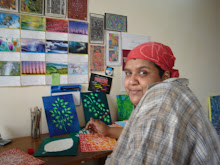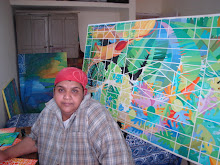2. ABORIGINAL DREAMSCAPES (TRIPTYCH)
3. THE THREE SISTERS (SINGLE)
4. MY ANIMAL GUIDES (SINGLE)
5. MY ANIMAL SPIRIT GUIDES (SINGLE)
Precisely 9 paintings have been done in this series using pen and ink and acrylics on cartridge and handmade paper. These paintings are basically a record of what I saw in my dreams while I was very ill a few years ago. I will not be doing such styles of paintings again as my dreams have been instrumental in guiding these paintings.
I no longer have such dreams.
ABORIGINAL DREAM TRAVELS



I have never been to Australia so I have no idea as to why I should have dreamt about these Australian aboriginals and their symbols.Perhaps I will understand their significance some day.
Aboriginal people are indigenous (the first) Australians. They tell stories in words and pictures about how the world began. They call this Dreamtime. Their stories are called Dreamings. The Australian Aborigines pay great attention to the dream state as they believe they are spiritual messages from their ancestors who are a part of nature.
This harmony between human existence and other natural things was expressed by Silas Roberts, first Chairman of the Northern Land Council, as:
Aboriginals see themselves as part of nature. We see all things natural as part of us. All the things on Earth we see as part human. This is told through the ideas of dreaming. By dreaming we mean the belief that long ago, these creatures started human society. These creatures, these great creatures are just as much alive today as they were in the beginning. They are everlasting and will never die. They are always part of the land and nature as we are. Our connection to all things natural is spiritual.
ABORIGINAL DREAMSCAPES



In many of my dreams I was always constantly on the move, travelling from one place to another, from one destination to another. It was as if I was familiar with the landscapes and the horizons but needed a little guidance. Often animals would guide me, sometimes it would be plants.I never really had conversations with the people that I met in my travels but they shared food and water with me and I took part in their rituals, dances, songs, celebrations and silences. I appreciate the fact that silence has its own chaos, its own music and its own sounds.
MY ANIMAL SPIRIT GUIDES

Sometimes I would travel for days with just the horizon in front of me. Except for the above painting 'My Animal Spirit Guides' all the other paintings are done with earthy reds, browns, oranges, blacks and whites - this is because the range of colours comprised of such colours.

Aboriginal Art uses earth colours. Why? These are the colours of the desert. Aboriginal artists made their paints from natural materials from the desert.
MY ANIMAL GUIDES

A common creature featured in all the paintings is The Snake or Serpent. This reptile for most seem to denote negativity - the snake or serpent in all my paintings signify new life, rebirth, change, and a new beginning. Mythological, in almost all cultures ranging from the Mayan, Egyptian, Greek, Mexican, Roman, Welsh, Russian, Indian and Aboriginal, The Serpent signifies regeneration as the snake is about the only animal that rejuvenates and regenerates its self by shedding its skin.
Briefly, the animals are representations of messages for eg. Turtle/Tortoise - Longevity, Wisdom and Knowledge, Fish - Strength, Agility and Speed, Moth/Butterfly - Metamorphosis, Change, Progress, New Beginning, The Lizard - Patience, Flexibility and so on.
Hieroglyphs for water is often a zigzag or wavy line representing waves of the sea or water signifying the water spirit - the waves always almost signify and are compared to a moving serpent. The serpent is often known as the great and powerful spirit and water a symbol of the unfathomable truth and wisdom. The serpent is often known as the great and powerful spirit and thus invariably identified as an alternative sign for the same idea thus becoming the symbol of Water Mother, Great Spirit, Celestial Wisdom and Perfect Power.
THE THREE SISTERS

Some of the aboriginal symbols I had done in my initial hospital sketches without understanding their meanings (which I later looked up)signify the following...
I was handed a book on an exhibition held by Dorothy Napangardi by Dr. Tilly Karuppiah of HUKM, Malaysia after she glanced through my hospital sketches. Many of the above artwork have adaptations of her real life photographs. Thank you Dorothy and thank you Tilly.
 Dorothy Napangardi (b. 1956) is a prolific Australian Aboriginal artist from Mina Mina and one of around 3,000 Warlpiri speakers who live in or are originally from the Tanami Desert region of Central Australia. She won the Telstra National Aboriginal & Torres Strait Islander Art Award in 2001 for her work, Salt on Mina Mina.
Dorothy Napangardi (b. 1956) is a prolific Australian Aboriginal artist from Mina Mina and one of around 3,000 Warlpiri speakers who live in or are originally from the Tanami Desert region of Central Australia. She won the Telstra National Aboriginal & Torres Strait Islander Art Award in 2001 for her work, Salt on Mina Mina.It would seem fit to define these dreams in medical terms by using psychological reasoning and terminology such as hallucinatory images, illusionary perceptions, subconscious imagery and so on. However, I would prefer to treat these moments as experiences that helped me and edged me on to recovery. When the body is weak for long periods, there comes a time when the mind weakens - I would like to say that these experiences were very real to me, I lived through them and I survived as a result of them - how weak the mind becomes I cannot say, but I can truly say that the mind and body have an amazing will to heal themselves.
There is so much more to write on aboriginal art and to begin would mean never to end so I reluctantly take my leave from these pages...to kiv for a later date.












